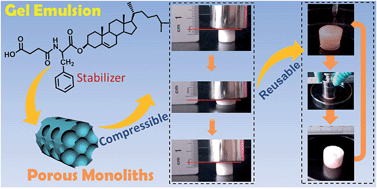Compressible porous hybrid monoliths: preparation via a low molecular mass gelators-based gel-emulsion approach and exceptional performances†
Abstract
A cholesteryl derivative, BuDphe, which is a low molecular mass gelator (LMMG), was synthesized and used as a stabilizer for the creation of a number of water/oil gel-emulsions, of which the oil could be a mixture of butyl methacrylate (t-BMA) and p-divinylbenzene (DVB), a mixture of t-BMA, DVB and polydimethylsilane (PDMS), or that of t-BMA, DVB, PDMS and trimethoxymethylsilane (MTMS). Polymerization of these mixtures resulted in porous polymeric or hybrid monoliths, M-1, M-2, M-3, M-4 and M-5, respectively, of which the first is a pure poly-t-BMA monolith, the second to the fourth ones contain an increasing amount of PDMS, and the last is a hybrid of poly-t-BMA, PDMS and hydrolyzed MTMS. The hybrid monoliths, in particular M-5, as prepared possess not only hydrophobicity, porosity, and low-density, but also an unprecedented flexibility in the dry state with a maximum shape recovery corresponding to 100% of the original thickness after more than 70% compression strain. Moreover, silylanization also improves the thermo-stability of the porous materials. An absorption test demonstrated that M-5 is an excellent absorbent for a number of organic solvents and oils. The material after absorption can be re-generated and the liquids absorbed can be recovered by simple squeezing. Furthermore, the absorption-separation process with CH2Cl2 as an example solvent could be repeated at least 10 times with no significant reduction of its absorption capacity. Combination of the excellent flexibility, great absorptivity, easiness in preparation, and low-energy consumption in drying makes the hybrid monoliths, in particular M-5, possess the potential to find real-life applications.


 Please wait while we load your content...
Please wait while we load your content...